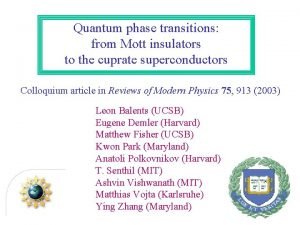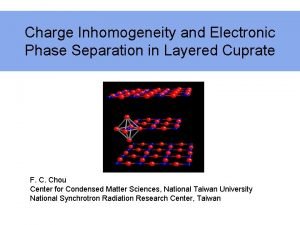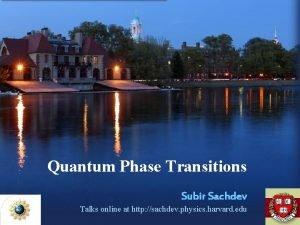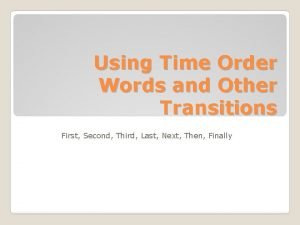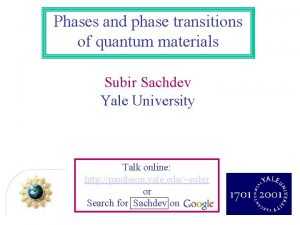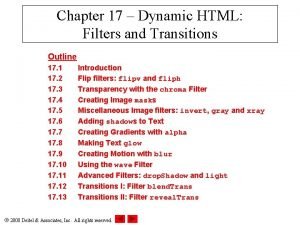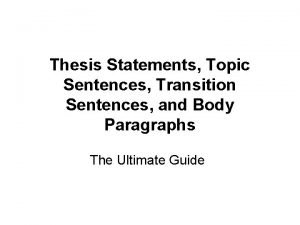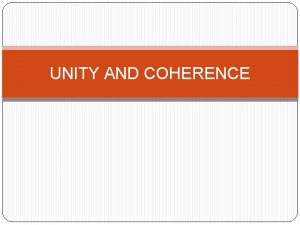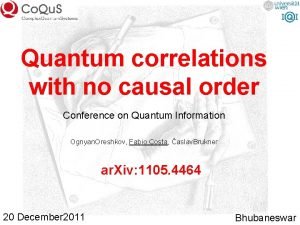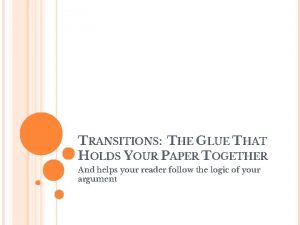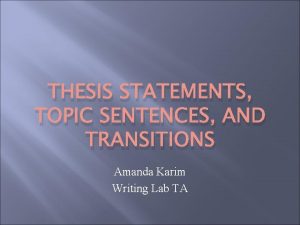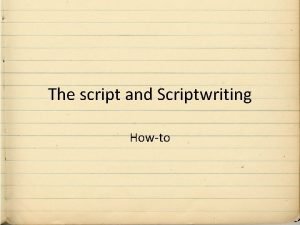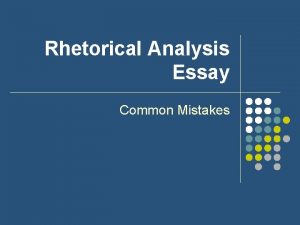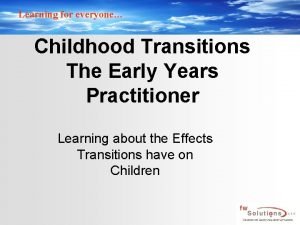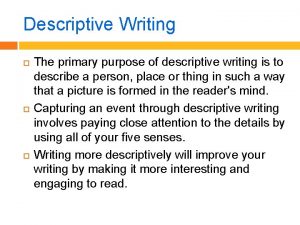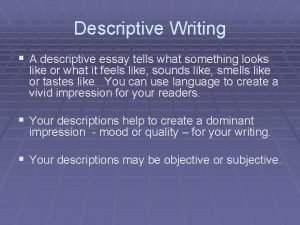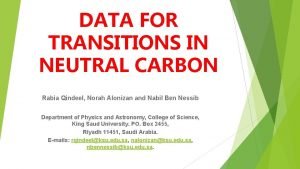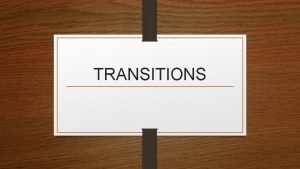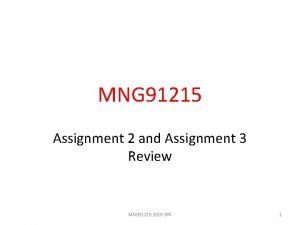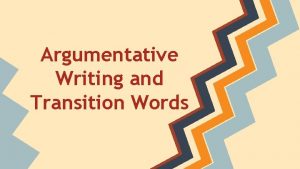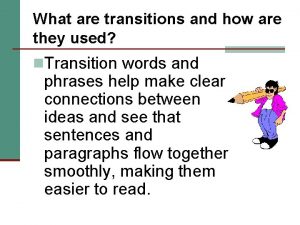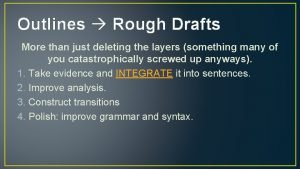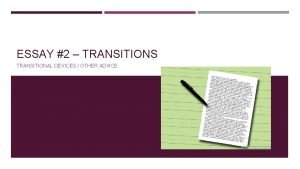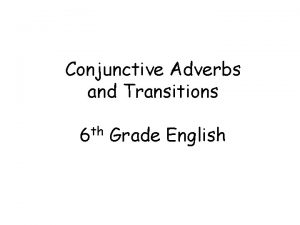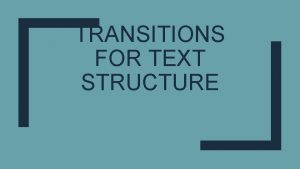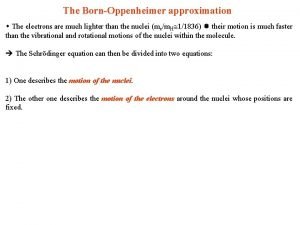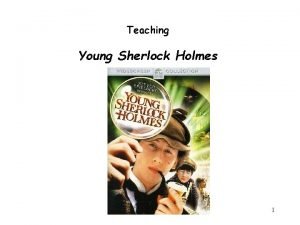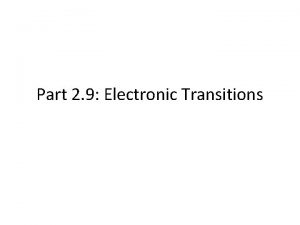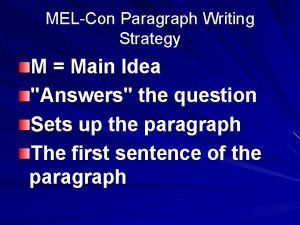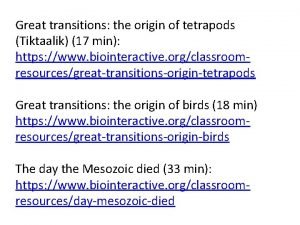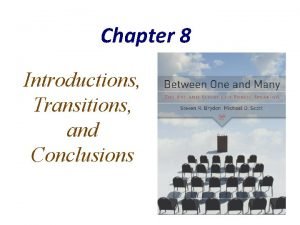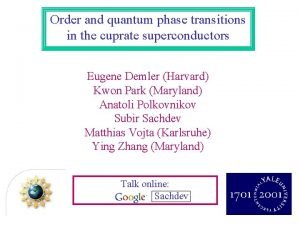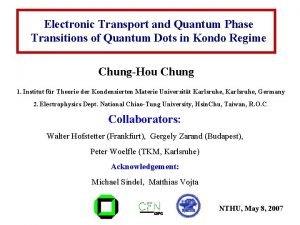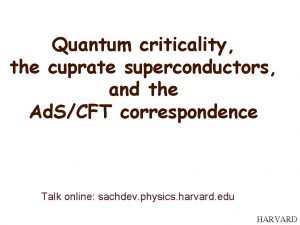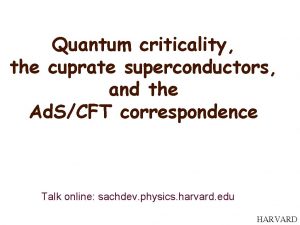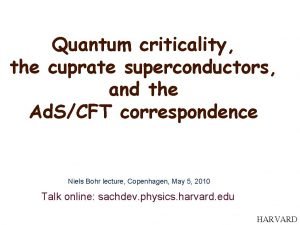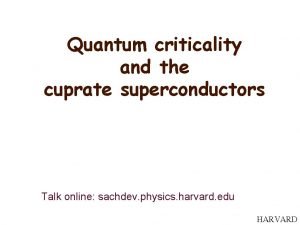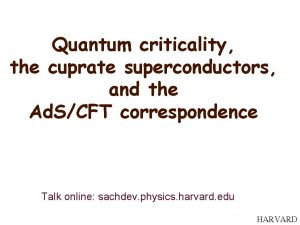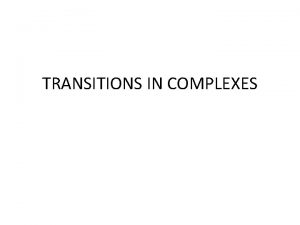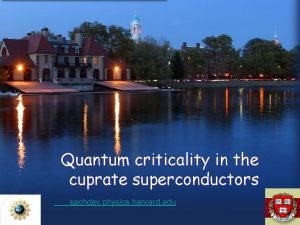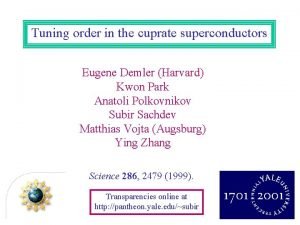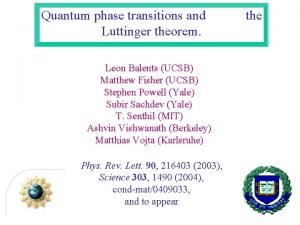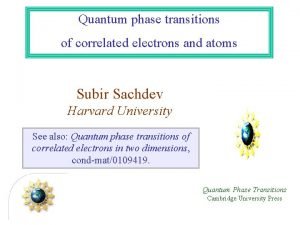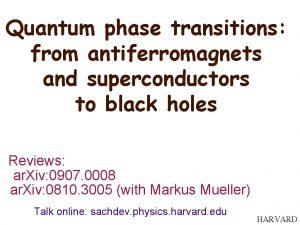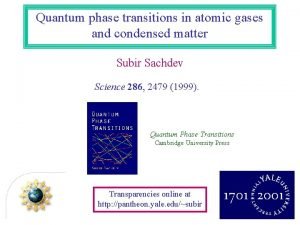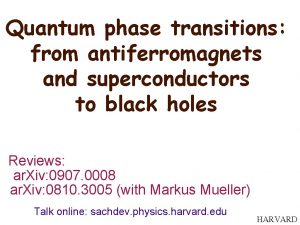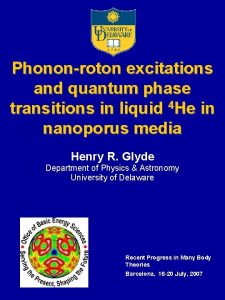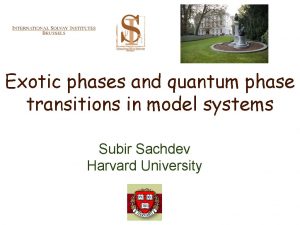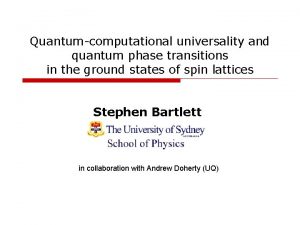Order and quantum phase transitions in the cuprate



















































- Slides: 51

Order and quantum phase transitions in the cuprate superconductors Eugene Demler (Harvard) Kwon Park Anatoli Polkovnikov Subir Sachdev Matthias Vojta (Augsburg) Ying Zhang Talk online at http: //pantheon. yale. edu/~subir

Parent compound of the high temperature superconductors: Mott insulator: square lattice antiferromagnet Ground state has long-range magnetic Néel order, or a “spin density wave (SDW)” Néel order parameter:

Introduce mobile carriers of density d by substitutional doping of out-of-plane ions e. g. Exhibits superconductivity below a high critical temperature Tc

Bose-Einstein condensation of Cooper pairs Several low temperature properties of the cuprate low superconductors appear to be qualitatively similar to those predicted by BCS theory.

Superconductivity in a doped Mott insulator Review: S. Sachdev, Science 286, 2479 (1999). Hypothesis: cuprate superconductors are characterized by additional order parameters, associated with the proximate Mott insulator, along with the familiar order associated with the Bose condensation of Cooper pairs in BCS theory. These orders lead to new low energy excitations. Predictions of BCS associated with underlying Fermi surface do not apply

Superconductivity in a doped Mott insulator Review: S. Sachdev, Science 286, 2479 (1999). Study physics in a generalized phase diagram which includes new phases (which need not be experimentally accessible) with longrange correlations in the additional order parameters. Expansion away from quantum critical points provides a systematic and controlled theory of the low energy excitations (including their behavior near imperfections such as impurities and vortices and their response to applied fields) and of crossovers into “incoherent” regimes at finite temperature.

Outline I. What is a quantum phase transition ? II. The simplest quantum phase transition Quantum Ising Chain III. Coupled Ladder Antiferromagnet IV. A global phase diagram V. Recent neutron scattering and STM experiments on the cuprates. VI. Conclusions

What is a quantum phase transition ? Non-analyticity in ground state properties as a function of some control parameter g E E g True level crossing: Usually a first-order transition g Avoided level crossing which becomes sharp in the infinite volume limit: second-order transition

Why study quantum phase transitions ? T Quantum-critical gc g • Theory for a quantum system with strong correlations: describe phases on either side of gc by expanding in deviation from the quantum critical point. • Critical point is a novel state of matter without quasiparticle excitations • Critical excitations control dynamics in the wide quantum-critical region at non-zero temperatures. No collective classical variables for large scale dynamics. Important property of ground state at g=gc : temporal and spatial scale invariance; characteristic energy scale at other values of g:

Outline I. What is a quantum phase transition ? II. The simplest quantum phase transition Quantum Ising Chain III. Coupled Ladder Antiferromagnet IV. A global phase diagram V. Recent neutron scattering and STM experiments on the cuprates. VI. Conclusions

I. Quantum Ising Chain 2 Jg

Full Hamiltonian leads to entangled states at g of order unity

Weakly-coupled qubits Ground state: Lowest excited states: Coupling between qubits creates “flipped-spin” quasiparticle states at momentum p p Entire spectrum can be constructed out of multi-quasiparticle states

Ground states: Strongly-coupled qubits Lowest excited states: domain walls Coupling between qubits creates new “domainwall” quasiparticle states at momentum p p

Entangled states at g of order unity “Flipped-spin” Quasiparticle weight Z A. V. Chubukov, S. Sachdev, and J. Ye, Phys. Rev. B 49, 11919 (1994) gc g Ferromagnetic moment N 0 P. Pfeuty Annals of Physics, 57, 79 (1970) gc g Excitation energy gap D

Crossovers at nonzero temperature Quasiclassical dynamics S. Sachdev and J. Ye, Phys. Rev. Lett. 69, 2411 (1992). S. Sachdev and A. P. Young, Phys. Rev. Lett. 78, 2220 (1997).

Outline I. What is a quantum phase transition ? II. The simplest quantum phase transition Quantum Ising Chain III. ladder antiferromagnet III. Coupled Ladder Antiferromagnet IV. A global phase diagram V. Recent neutron scattering and STM experiments on the cuprates. VI. Conclusions

II. Coupled Ladder Antiferromagnet N. Katoh and M. Imada, J. Phys. Soc. Jpn. 63, 4529 (1994). J. Tworzydlo, O. Y. Osman, C. N. A. van Duin, J. Zaanen, Phys. Rev. B 59, 115 (1999). M. Matsumoto, C. Yasuda, S. Todo, and H. Takayama, Phys. Rev. B 65, 014407 (2002). S=1/2 spins on coupled 2 -leg ladders

Square lattice antiferromagnet Experimental realization: Ground state has long-range magnetic (Neel) order Excitations: 2 spin waves

Weakly coupled ladders Real space Cooper pairs with their charge localized. Upon doping, motion and Bose-Einstein condensation of Cooper pairs leads to superconductivity Paramagnetic ground state

Excitations Excitation: S=1 exciton (spin collective mode) Energy dispersion away from antiferromagnetic wavevector S=1/2 spinons are confined by a linear potential.

T=0 Neel order N 0 c Spin gap D 1 Neel state Magnetic order as in La 2 Cu. O 4 Quantum paramagnet Electrons in charge-localized Cooper pairs d in cuprates ?

Paramagnetic ground state of coupled ladder model

Can this be a paramagnetic ground state of a system with full square lattice symmetry ? Such a state breaks lattice symmetry by the appearance of bond order Such bond order is generic in paramagnetic states proximate to a magnetic state with collinear spins N. Read and S. Sachdev, Phys. Rev. Lett. 62, 1694 (1989).

Origin of bond order Quantum “entropic” effects prefer bond-ordered configurations in which the largest number of singlet pairs can resonate. The state on the upper left has more flippable pairs of singlets than the on the lower left. These effects lead to a broken square lattice symmetry near the transition to the magnetically ordered states with collinear spins.

Outline I. What is a quantum phase transition ? II. The simplest quantum phase transition Quantum Ising Chain III. Coupled Ladder Antiferromagnet IV. A global phase diagram V. Recent neutron scattering and STM experiments on the cuprates. VI. Conclusions

Order parameters in the cuprate superconductors 1. Pairing order of BCS theory Bose-Einstein condensation of Cooper pairs Orders associated with proximate Mott insulator 2. Collinear magnetic order 3. Bond order For most wavevectors, these orders also imply a modulation in the site charge density (“charge order”). However, the amplitude of the charge order should be strongly suppressed by Coulomb interactions. S. Sachdev and N. Read, Int. J. Mod. Phys. B 5, 219 (1991).

Doping a paramagnetic bond-ordered Mott insulator Systematic Sp(N) theory of translational symmetry breaking, while preserving spin rotation invariance. T=0 d-wave superconductor Instability to phase separation below this line Superconductor with co-existing bond-order Mott insulator with bond-order S. Sachdev and N. Read, Int. J. Mod. Phys. B 5, 219 (1991).

IV. A global phase diagram Include long-range Coulomb interactions: frustrated phase separation V. J. Emery, S. A. Kivelson, and H. Q. Lin, Phys. Rev. Lett. 64, 475 (1990). Bond order Collinear magnetic order M. Vojta and S. Sachdev, Phys. Rev. Lett. 83, 3916 (1999) M. Vojta, Y. Zhang, and S. Sachdev, Phys. Rev. B 62, 6721 (2000). M. Vojta, Phys. Rev. B 66, 104505 (2002). See also J. Zaanen, Physica C 217, 317 (1999), S. White and D. J. Scalapino, Phys. Rev. Lett. 80, 1272 (1998). C. Castellani, C. Di Castro, and M. Grilli, Phys. Rev. Lett. 75, 4650 (1995). S. Mazumdar, R. T. Clay, and D. K. Campbell, Phys. Rev. B 62, 13400 (2000).

Outline I. What is a quantum phase transition ? II. The simplest quantum phase transition Quantum Ising Chain III. Coupled Ladder Antiferromagnet IV. A global phase diagram Recent neutron scattering and STM experiments on the V. Recent neutron scattering and STM experiments on the cuprates. VI. Conclusions

V. Tuning magnetic order in LSCO by a magnetic field T=0 phases of LSCO ky /a 0 Insulator • /a Néel SDW 0 0. 02 0. 055 kx SC+SDW ~0. 12 -0. 14 SC (additional commensurability effects near =0. 125) J. M. Tranquada et al. , Phys. Rev. B 54, 7489 (1996). G. Aeppli, T. E. Mason, S. M. Hayden, H. A. Mook, J. Kulda, Science 278, 1432 (1997). S. Wakimoto, G. Shirane et al. , Phys. Rev. B 60, R 769 (1999). Y. S. Lee, R. J. Birgeneau, M. A. Kastner et al. , Phys. Rev. B 60, 3643 (1999) S. Wakimoto, R. J. Birgeneau, Y. S. Lee, and G. Shirane, Phys. Rev. B 63, 172501 (2001).

V. Tuning magnetic order in LSCO by a magnetic field T=0 phases of LSCO ky /a 0 • • /a Néel SDW 0 0. 02 0. 055 Insulator kx SC+SDW ~0. 12 -0. 14 SC (additional commensurability effects near =0. 125) J. M. Tranquada et al. , Phys. Rev. B 54, 7489 (1996). G. Aeppli, T. E. Mason, S. M. Hayden, H. A. Mook, J. Kulda, Science 278, 1432 (1997). S. Wakimoto, G. Shirane et al. , Phys. Rev. B 60, R 769 (1999). Y. S. Lee, R. J. Birgeneau, M. A. Kastner et al. , Phys. Rev. B 60, 3643 (1999) S. Wakimoto, R. J. Birgeneau, Y. S. Lee, and G. Shirane, Phys. Rev. B 63, 172501 (2001).

V. Tuning magnetic order in LSCO by a magnetic field T=0 phases of LSCO ky /a 0 Superconductor with Tc, min =10 K • • /a Néel SDW 0 0. 02 0. 055 kx SC+SDW ~0. 12 -0. 14 SC (additional commensurability effects near =0. 125) J. M. Tranquada et al. , Phys. Rev. B 54, 7489 (1996). G. Aeppli, T. E. Mason, S. M. Hayden, H. A. Mook, J. Kulda, Science 278, 1432 (1997). S. Wakimoto, G. Shirane et al. , Phys. Rev. B 60, R 769 (1999). Y. S. Lee, R. J. Birgeneau, M. A. Kastner et al. , Phys. Rev. B 60, 3643 (1999) S. Wakimoto, R. J. Birgeneau, Y. S. Lee, and G. Shirane, Phys. Rev. B 63, 172501 (2001).

Spin density wave order Collinear spins

V. Tuning magnetic order in LSCO by a magnetic field T=0 phases of LSCO ky /a 0 Superconductor with Tc, min =10 K • • /a Néel SDW 0 0. 02 0. 055 kx SC+SDW ~0. 12 -0. 14 SC Use simplest assumption of a direct second-order quantum phase transition between SC and SC+SDW phases

G. Aeppli, T. E. Mason, S, M. Hayden, H. A. Mook, and J. Kulda, Science 278, 1432 (1998).

V. Tuning magnetic order in LSCO by a magnetic field T=0 phases of LSCO H ky /a 0 Superconductor with Tc, min =10 K • • /a Néel SDW 0 0. 02 0. 055 kx SC+SDW ~0. 12 -0. 14 SC Use simplest assumption of a direct second-order quantum phase transition between SC and SC+SDW phases Follow intensity of elastic Bragg spots in a magnetic field

Zeeman term: only effect in coupled ladder system H SC+SDW Spin singlet state SC dc d Characteristic field gm. BH = D, the spin gap 1 Tesla = 0. 116 me. V Effect is negligible over experimental field scales

Dominant effect with coexisting superconductivity: uniform softening of spin excitations by superflow kinetic energy Competing order is enhanced in a “halo” around each vortex E. Demler, S. Sachdev, and Ying Zhang, Phys. Rev. Lett. 87, 067202 (2001).

Main results “Normal” (Bond order) dc d E. Demler, S. Sachdev, and Ying Zhang, Phys. Rev. Lett. 87, 067202 (2001). D. P. Arovas, A. J. Berlinsky, C. Kallin, and S. -C. Zhang, Phys. Rev. Lett. 79, 2871 (1997) proposed static local spins within vortex cores in SC phase T=0

Neutron scattering measurements of static spin correlations of the superconductor+spin-density-wave (SC+SDW) in a magnetic field H (Tesla)

B. Lake, H. M. Rønnow, N. B. Christensen, G. Aeppli, K. Lefmann, D. F. Mc. Morrow, P. Vorderwisch, P. Smeibidl, N. Mangkorntong, T. Sasagawa, M. Nohara, H. Takagi, T. E. Mason, Nature, 415, 299 (2002). See also S. Katano, M. Sato, K. Yamada, T. Suzuki, and T. Fukase, Phys. Rev. B 62, R 14677 (2000).

Neutron scattering observation of SDW order enhanced by superflow. “Normal” (Bond order) Prediction: SDW fluctuations enhanced by superflow and bond order pinned by vortex cores (no spins in vortices). Should be observable in STM dc d K. Park and S. Sachdev Phys. Rev. B 64, 184510 (2001). Y. Zhang, E. Demler and S. Sachdev, Phys. Rev. B 66, 094501 (2002).

STM around vortices induced by a magnetic field in the superconducting state J. E. Hoffman, E. W. Hudson, K. M. Lang, V. Madhavan, S. H. Pan, H. Eisaki, S. Uchida, and J. C. Davis, Science 295, 466 (2002). Local density of states 1Å spatial resolution image of integrated LDOS of Bi 2 Sr 2 Ca. Cu 2 O 8+d ( 1 me. V to 12 me. V) at B=5 Tesla. S. H. Pan et al. Phys. Rev. Lett. 85, 1536 (2000).

Vortex-induced LDOS of Bi 2 Sr 2 Ca. Cu 2 O 8+d integrated from 1 me. V to 12 me. V 7 p. A b 0 p. A 100Å J. Hoffman E. W. Hudson, K. M. Lang, V. Madhavan, S. H. Pan, H. Eisaki, S. Uchida, and J. C. Davis, Science 295, 466 (2002).

Fourier Transform of Vortex-Induced LDOS map K-space locations of vortex induced LDOS K-space locations of Bi and Cu atoms Distances in k –space have units of 2 p/a 0 a 0=3. 83 Å is Cu-Cu distance J. Hoffman et al. Science, 295, 466 (2002).

Fourier Transform of Vortex-Induced LDOS map K-space locations of vortex induced LDOS Our interpretation: LDOS modulations are signals of bond order of period 4 revealed in vortex halo

V. STM image of LDOS modulations in Bi 2 Sr 2 Ca. Cu 2 O 8+d in zero magnetic field Period = 4 lattice spacings C. Howald, H. Eisaki, N. Kaneko, and A. Kapitulnik, cond-mat/0201546

Spectral properties of the STM signal are sensitive to the microstructure of the charge order Theoretical modeling shows that this spectrum is best obtained by a modulation of bond variables, such as the exchange, kinetic or pairing energies. Measured energy dependence of the Fourier component of the density of states which modulates with a period of 4 lattice spacings M. Vojta, Phys. Rev. B 66, 104505 (2002); C. Howald, H. Eisaki, N. Kaneko, and A. Kapitulnik, cond-mat/0201546 D. Podolsky, E. Demler, K. Damle, and B. I. Halperin, cond-mat/0204011

Global phase diagram Bond order Collinear magnetic order STM Neutrons M. Vojta and S. Sachdev, Phys. Rev. Lett. 83, 3916 (1999) M. Vojta, Y. Zhang, and S. Sachdev, Phys. Rev. B 62, 6721 (2000). M. Vojta, Phys. Rev. B 66, 104505 (2002); . See also J. Zaanen, Physica C 217, 317 (1999), V. J. Emery, S. A. Kivelson, and H. Q. Lin, Phys. Rev. Lett. 64, 475 (1990). S. White and D. Scalapino, Phys. Rev. Lett. 80, 1272 (1998). C. Castellani, C. Di Castro, and M. Grilli, Phys. Rev. Lett. 75, 4650 (1995). S. Mazumdar, R. T. Clay, and D. K. Campbell, Phys. Rev. B 62, 13400 (2000).

Conclusions I. Cuprate superconductivity is associated with doping Mott insulators with charge carriers. II. Order parameters characterizing the Mott insulator compete with the order associated with the Bose-Einstein condensation of Cooper pairs. III. Classification of Mott insulators shows that the appropriate order parameters are collinear magnetism and bond order. IV. Theory of quantum phase transitions provides semiquantitative predictions for neutron scattering measurements of spin-density-wave order in superconductors; theory also proposes a connection to STM experiments. V. Future experiments should search for SC+SDW to SC quantum transition driven by a magnetic field.
 Cuprate charge order
Cuprate charge order Cuprate charge order
Cuprate charge order Subir sachdev quantum phase transitions
Subir sachdev quantum phase transitions Time order words examples
Time order words examples Quantum physics vs quantum mechanics
Quantum physics vs quantum mechanics Quantum physics vs quantum mechanics
Quantum physics vs quantum mechanics 1st order 2nd order 3rd order neurons
1st order 2nd order 3rd order neurons Quantum phase transition
Quantum phase transition Mobile phase and stationary phase
Mobile phase and stationary phase Stationary phase in gas chromatography
Stationary phase in gas chromatography Adsorption chromatography
Adsorption chromatography Vertical blinds
Vertical blinds Example of topic sentence
Example of topic sentence Unity and coherence examples
Unity and coherence examples Quantum correlations with no causal order
Quantum correlations with no causal order Normal phase vs reverse phase chromatography
Normal phase vs reverse phase chromatography Tswett pronunciation
Tswett pronunciation Normal phase vs reverse phase chromatography
Normal phase vs reverse phase chromatography Line current and phase current
Line current and phase current In a triangle connected source feeding a y connected load
In a triangle connected source feeding a y connected load Broad phase vs narrow phase
Broad phase vs narrow phase Trim video windows live movie maker
Trim video windows live movie maker Conclusion transitions
Conclusion transitions Amanda karim
Amanda karim Script writing elements
Script writing elements Modern project profiles in spm
Modern project profiles in spm Transitions for rhetorical analysis
Transitions for rhetorical analysis Melcon writing
Melcon writing Mel-con
Mel-con Effects of transitions in early years
Effects of transitions in early years Purpose of descriptive writing
Purpose of descriptive writing Transitions for descriptive essays
Transitions for descriptive essays Rabia transitions
Rabia transitions Logical transitions
Logical transitions William bridges transitions model
William bridges transitions model Linking words argumentative essay
Linking words argumentative essay Tlq transitions
Tlq transitions What are transitions
What are transitions Elaboration transition words
Elaboration transition words Tlq transitions
Tlq transitions Transitional devices definition
Transitional devices definition Conjunctive adverb
Conjunctive adverb Problem and solution transition words
Problem and solution transition words Weller health transitions
Weller health transitions Transition words sixth grade
Transition words sixth grade Electronic transitions
Electronic transitions Rametep
Rametep Spin forbidden
Spin forbidden Melcon paragraph
Melcon paragraph National transitions of care coalition
National transitions of care coalition Great transitions the origin of tetrapods
Great transitions the origin of tetrapods Transitions for conclusions
Transitions for conclusions
